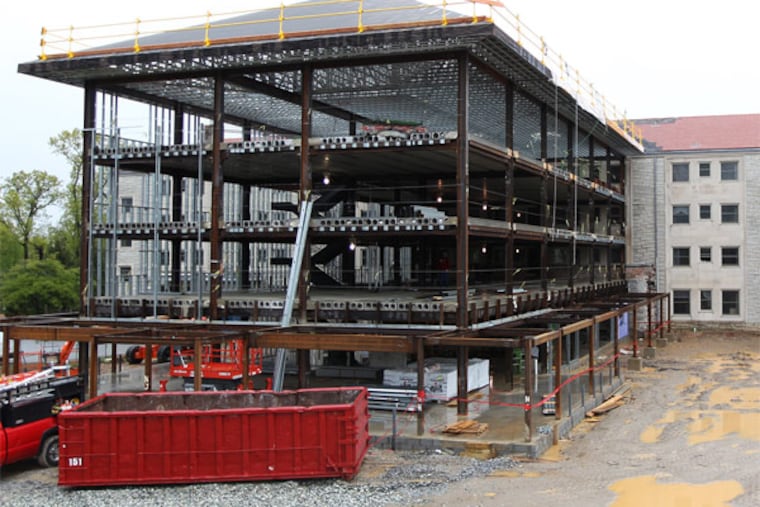Camilla Hall undergoing $19M renovation
The nuns of the Immaculate Heart of Mary have taught generations of children in the Philadelphia area. And when they were too frail or sick to work they retired to Camilla Hall, an austere nursing home on the campus of Immaculata College in Malvern.

The nuns of the Immaculate Heart of Mary have taught generations of children in the Philadelphia area. And when they were too frail or sick to work they retired to Camilla Hall, an austere nursing home on the campus of Immaculata College in Malvern.
Lately, the sisters have been retiring in droves. Almost a quarter of the order's 822 nuns live at Camilla Hall and that number is expected to grow over the next decade.
"Our median age is 72," said Sister Anne Veronica, administrator of the nursing home.
To accommodate the influx, Camilla Hall is undergoing a $19 million renovation and expansion that will update the aging building for the 21st century with more social and activity rooms, specialized bathing and massage areas, enhanced nursing stations, and medical offices, cafe lounges, and outdoor porches.
"We're trying to make the home as person-centered as possible," said Sister Anne.
The nuns, who receive no money from the Archdiocese of Philadelphia, are paying for the renovation through a $10 million construction loan, a $6 million capital campaign that they are halfway through, and money from the congregation's retirement funds.
Bonnie Ashby, the home's medical director and a member of the capital campaign committee, said everyone is pitching in to raise funds, from hosting cocktail parties to staging a dog show this Saturday weekend at Immaculata.
"They are phenomenal," Ashby, the dog show organizer, said of the sisters. "They are very, very capable people and really know what they're doing. They don't get support from anyone."
The facility provides excellent care, she said, but needed to be modernized.
"It's a very nice place for them, it's going to be nicer," she said.
Since the mid-1800s, Immaculate Heart of Mary sisters have staffed parochial schools throughout Pennsylvania. Ninety percent of them still work in the region, but the order has convents in seven states as well as Peru and Chili.
The last big surge in membership was in the mid-1960s, when an average of 100 young women a year joined the order, compared with two or three today.
Now those women are reaching retirement age "and that is what is causing our spurt," said Sister Ann, who entered the convent in 1966 with 90 others. In just two years, at the height of the women's movement, the sexual revolution, and the Second Vatican Council's opening of the church to lay leadership, new membership dropped to 40.
Today, Camilla Hall, a stone and stucco building built in 1960 that looks like the large imposing Catholic high schools from the same era, houses 195 nuns, most of them permanent residents.
The home expects to get up to 225 in the next two to three years, with the number of retirees peaking around 2020.
For the nuns who live and work at Camilla, most of whom still wear blue habits and a cheerful demeanor, the upgrade is long overdue.
"It's a dream come true," said Sister Mary Rosina, director of health services who has toiled at the nursing home for 45 years.
Sisters need more amenities such as community and exercise rooms, she said. Right now, there are a few small lounges and wooden benches in the hall if they want to sit together and chat. Exercise equipment consists of a treadmill, elliptical and stationary bicycle wedged into the end of hallways.
When it was opened, the nursing home had 300 bedrooms and few homey touches, in keeping with the austerity of religious life at the time. Over the years, some of the bedrooms were converted into medical offices, a pharmacy and storage areas. Most bedrooms and bathrooms still aren't handicap-accessible.
In addition to about 15 more bedrooms and new medical offices, the renovation will include more social rooms with TVs, games and Wii systems, two outdoor porches, a bigger dining room, and smaller dining areas on upper floors for those who can't come downstairs.
"Religious life has changed and health care has changed," Sister Anne said.
Sister Mary Shaun, who has lived at Camilla for 29 years and teaches art, welcomes the changes, especially the bigger art room.
"We needed to update," said Sister Mary, who is 88 and gets around on a motorized scooter. Some may resist the change, "but if you step out of your comfort zone you may step into another comfort zone."
Sister John Joseph, 73, a nurse at Camilla for 48 years, said "We envisioned this for years."
The new whirlpools will be a great help to nuns with arthritic joints, she said. The four they have now, one of which is broken, aren't nearly enough.
"They love it," she said as she cut the hair of Sister Marie Philippine. But just as important as the medical improvements, will be the enhanced sense of community from the homier accommodations. "People need that family spirit."